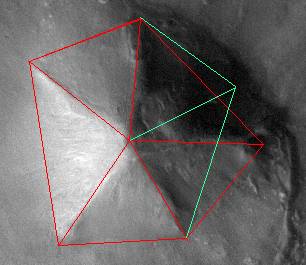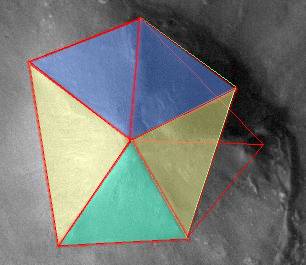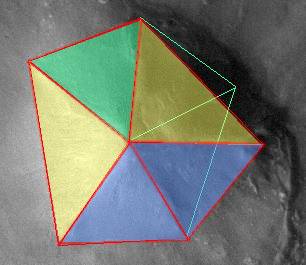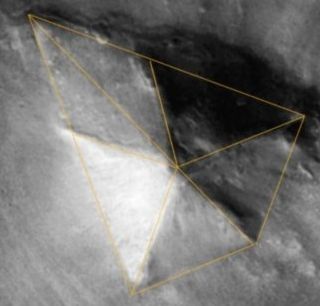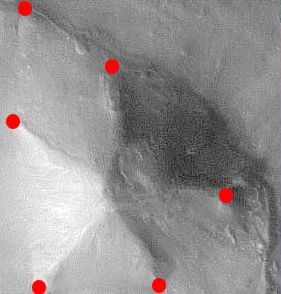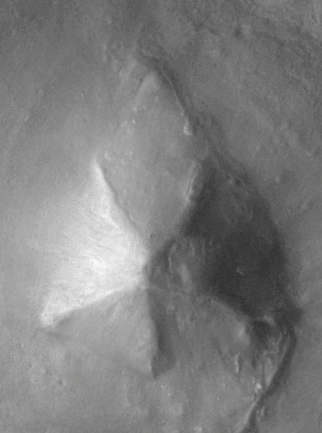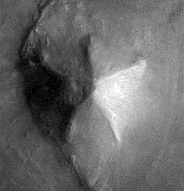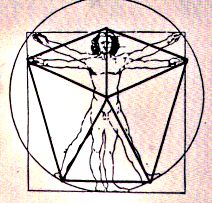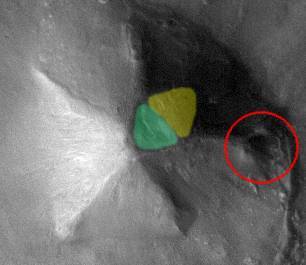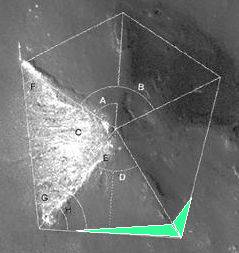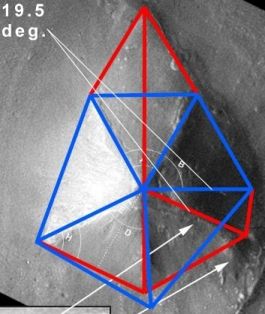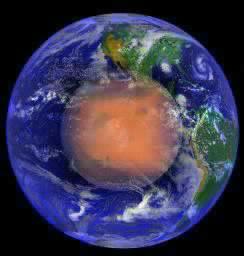 Cydonia Quest C Geometry C C c Mars Odyssey Reveals New Geometry in the D&M Pyramid Part Two cccccccccccccccccccccccccccccc C Summary of conclusions so far. In Part One (click µµµ) of this analysis it was concluded that - "It can be seen that a similar type of geometrical pattern appears to have been encoded into the D&M "Pyramid" twice over." This was because the new Mars Odyssey image had identified a new fifth ridge line in the D&M in addition to the north east buttress (or Isolated Buttress) first seen in Viking images. As a result of this discordance between the direction of the newly discovered ridge line and the location of the Isolated Buttress two similar bi-symmetrical pentagonal shapes co-exist within the confines of the D&M. Firstly, there is the southerly pointing pentagonal shape of the actual floor plan of the D&M traced out by the ends of the D&M's five ridge lines. Secondly, there is the northerly pointing pentagonal shape traced out by four of the D&M's five corners and the Isolated Buttress. Erol Torun's geometrical analysis has shown that an idealised version of this latter shape has some interesting mathematical characteristics, (see µµµ). As will be seen later there is a high degree of agreement between the idealised version of the North pointing pentagonal shape and what can be seen in the Mars Odyssey image. Northerly Pentagonal Shape----------------------------Southerly Pentagonal Shape
c The diagrams above have been drawn free-hand without any reference to idealised geometries. In Part Three of this study of D&M geometry an attempt will be made to see whether it's newly discovered southerly pointing floor plan conforms to an idealised geometry similar to Erol Torun's. The remainder of Part Two will now be devoted to exploring the interesting observations on D&M geometry by other researchers and to why the hypothetical builders of the D&M added the Isolated (north east) Buttress to the design. c The D&M : A Diamond of a Pyramid The Enterprise Mission has a lively discussion board for readers. Several contributors to the board had noticed a very interesting relationship between the southerly pointing floor plan of the D&M and a triangular platform sprouting from the base of the North facet. Although partially covered with debris it was apparent that the shape that best fitted this platform was an equilateral triangle - which also happens to be the best description of the D&M facet it adjoins. The two triangles seem to be mirror images of one another. By adding the shape of the platform to the floor plan of the D&M a diamond or arrowhead shape resulted. The first diagram posted to the board by Keith Laney from his own website (µµµ) shows a general schematic in the image below, left. Joao Espadinha's diagram on the right shows the anchoring points that make up the diamond shape. The bottom animated diagram was contributed by someone only known as "Dufusyte". This rotates the axis of the D&M "Pyramid" to vertical and shows how closely the floor plan and ridges adhere to a bi-symmetrical geometry of some sort.
ccccccccccccccccccccccccccccc c Another piece of image analysis by Mark Carlotto for the New Frontiers in Science internet magazine (µµµ) re-orientates the D&M pointy side up and flips its East and West sides over in a way that provides stunning confirmation of its internal symmetry. The pentagonal shape and the placement of the ridge lines bear a striking resemblance to Leonardo Da Vinci's "man in a squared circle" diagram.
C The Enterprise Mission has also posted a preliminary geometrical analysis of the D&M "Pyramid" to its own website. However, before reviewing that article this would be a useful to juncture to present a hypothesis as to why the D&M incorporates two co-existing pentagonal geometries. c The D&M Pyramid and the "Doh!" Factor Of course any hypothesis to explain the D&M having two pentagonal geometries presupposes that the D&M is an artificial construction - but in light of the images above that isn't a ridiculous working assumption. The Mars Odyssey has revealed that the floor plan, ridge lines and facets of the D&M are not based entirely around Erol Torun's northerly pointing pentagon as we had previously believed. Yet, the geometry proposed by Torun still has validity because of the existence of the Isolated Buttress in the North East of the D&M. The question is, why did the hypothetical builders of the D&M spoil their pristine five sided pyramid design by adding this structurally redundant buttress? Well if we look at the D&M in relation to the "Face" and the "City" we can see that they are all contained within the invisible framework of an equilateral triangle, (click "stargate" µµµ). This suggests that they were all designed at the same time to fit into the same "city plan" . A line drawn between the peak of the D&M and the Isolated Buttress extended for a distance over the Cydonia plain eventually ends up at the peak of the "Tholus", another possible artificial construction (µµµ). Given the distance of the "Tholus" from the main clutch of Cydonia anomalies it may have been a late addition by the hypothetical builders. In planning the exact location of the "Tholus" the Cydonia planners may have decided that it would be pleasing if this fed back significantly into the geometry of the D&M. Now, if the existing design of the D&M already incorporated Torun style geometrical relationships then it should have been possible to build an Isolated Buttress onto the D&M and locate the "Tholus" in such a way that a new geometrically significant pentagonal pattern was created within the pyramid. (At this point a surreal image has popped into the author's head of a five eyed alien architect flailing its myriad tentacles in the air and hysterically screaming, "You want to do what to my beautiful pyramid?!", when told of plans for the new buttress). Given the chaotic jumble on the slopes of the East side of the D&M it entirely possible that a narrow, decorative and structurally redundant ridge line was also added along the original surface between the Isolated Buttress and the D&M peak. Image analysis by Cydonia Quest of the pictures capturing the D&M by Mars Odyssey and the Mars Global Surveyor (only partially) suggests that as well as the triangular depression and accompanying uplift near the top of the D&M there are also depressed basins lower down the slope. This could be evidence of the surface collapsing into the large interior spaces that we would expect in an arcology, (click "stargate" for explanation µµµ). If this collapse happened catastrophically and there was air in the D&M this could explain the gaping hole that was dubbed the "Bottomless Pit" in the Viking images. In Part One of this study it was suggested that this walled pit might be the result of a smaller hollow mound caving in, (which could have been built to cover up an existing buttress when the Isolated Buttress was added, µµµ). A massive collapse of the East side of the D&M might have forced air along tunnels leading into this proposed mound causing an explosive increase in air pressure and causing it to burst like a balloon. (See image below). cccccccccccccccccccccccccccc c TEM's Take on the Odyssey Image The Enterprise Mission (TEM) chose to focus most of their text and diagrams on showing how well the Erol Torun geometry fitted its five points of reference on the D&M, (µµµ). As the illustration below shows it is only in the area coloured green around the South East buttress that there is a gap between the observed edge of the D&M and Torun's geometry. (Of course the line from the South East buttress to the Isolated -north east- Buttress is now known to cut across the eastern ridge line of the formation). TEM make the plausible suggestion that this discrepancy around the South East buttress is because its base has been covered by loose debris. This raises the exciting possibility that this hypothesis may be verified by a night time infra-red image of the D&M taken by Mars Odyssey in the future. (Any buried part of the buttress may show up due to its better heat retaining characteristics over loose earth).
c In assessing Part One of this study TEM make the following curious comments - "An additional, and very intriguing angle on this whole issue (sorry, more puns) was pointed out to us by Robert Harrison over at the Cydonia Quest web site. Bob noticed that there seemed to be an additional ridge line near the D&M, which he determined created a slightly differently oriented but almost identically-shaped pentagonal figure. Now, although he's wrong about this (Sorry Bob! You're using the exposed SE buttress as a starting point, but only the upper part is exposed) it did quickly become clear that his newly discovered ridge line was part of something very important - a Platform!" From this it might be supposed that TEM is rejecting the existence of the newly discovered southerly pointing pentagonal design of the D&M floor plan. This would be surprising. However, when TEM comes to put forward its own diagram for a dual geometry for the D&M it can be seen that they actually take it very seriously (although their accompanying text is a little too sparse to make this plain). In the TEM diagram above (right) the blue lines represent Erol Torun's geometric figure. The red lines represent TEM's proposal for the co-existing geometry. It can be seen immediately that this new figure is none other than the diamond shape that results from joining the triangular platform to the southerly pointing pentagonal layout of the D&M as seen in "Dufusyte's" animated image earlier - with only one small exception. TEM's diamond diagram has a small kink in it to take in the Isolated Buttress. So there is actually an almost total agreement between TEM and other Cydonia researchers on the diamond/arrowhead geometry. Interestingly TEM's diagram suggests the possibility that the angle between the D&M peak to Isolated Buttress and the newly discovered ridge line might have been designed as Hoagland's "hyperdimensional" angle of 19.5 degrees, (click "stargate" for details µµµ). Amusingly, after chiding Cydonia Quest for using the part of the South East buttress that can be seen (rather than the edge that TEM thinks is buried), TEM then go and do the same thing with the red lines on their dual geometry diagram. (Is that the far away sound of someone saying "Doh!" perhaps?). µ Proceed to Part Three C µ Return to Geometry Page µ Return to Mars Page µ Return to the Cydonia Quest main page |
